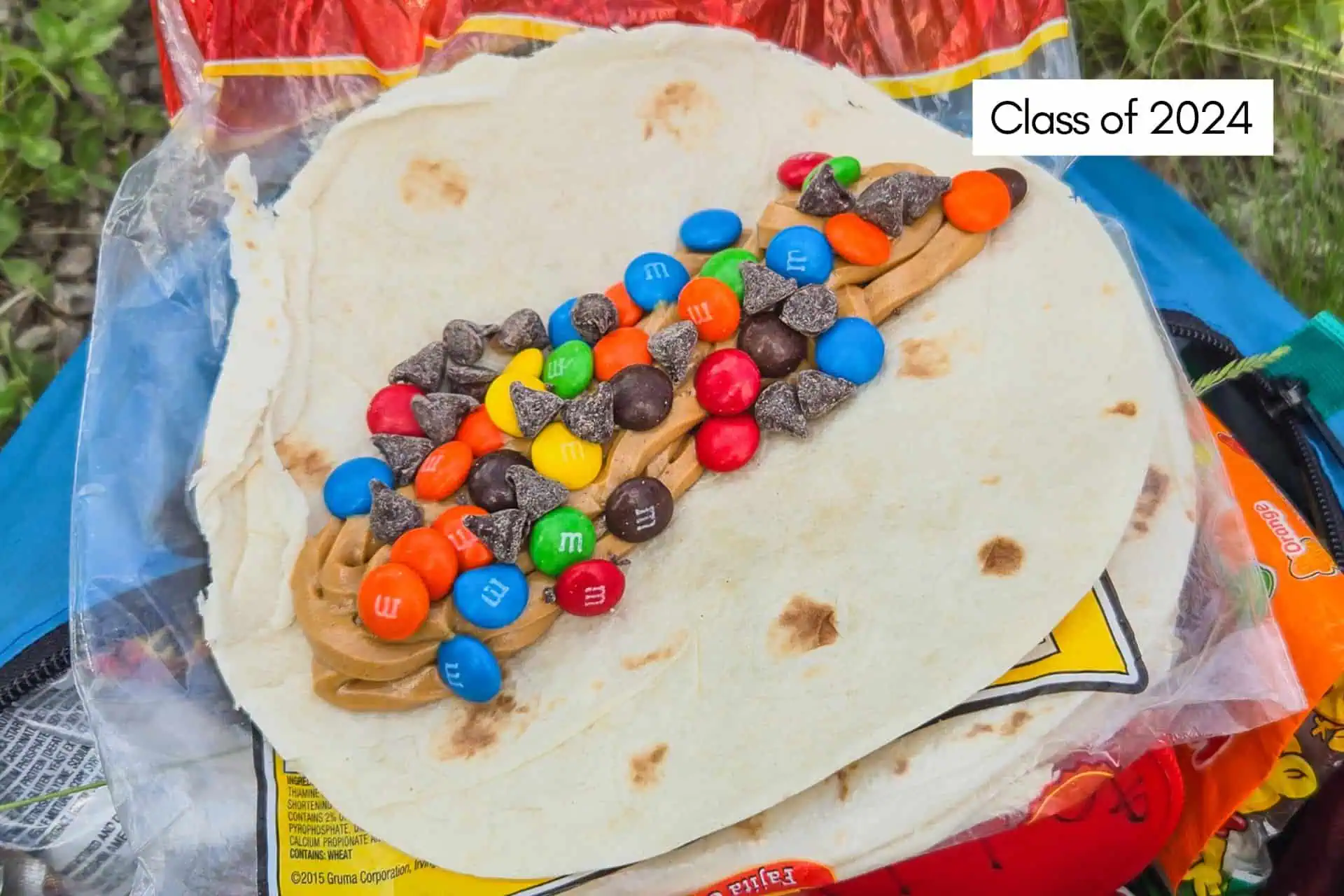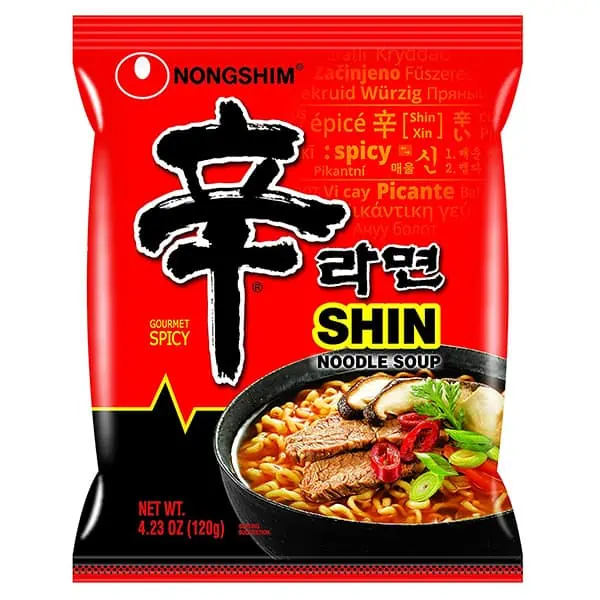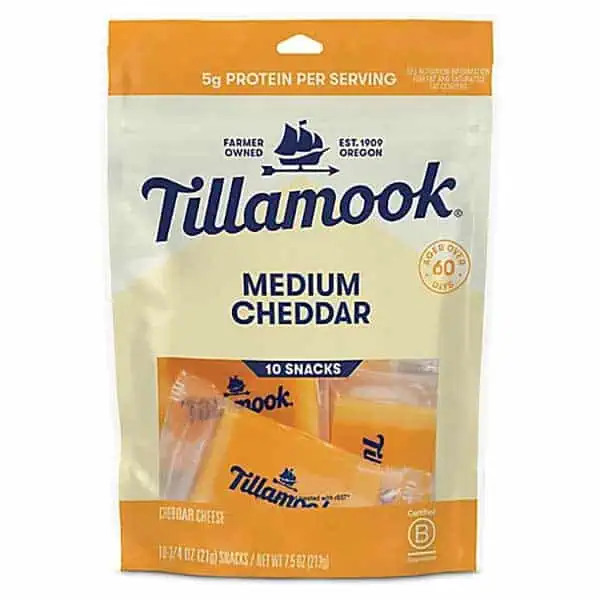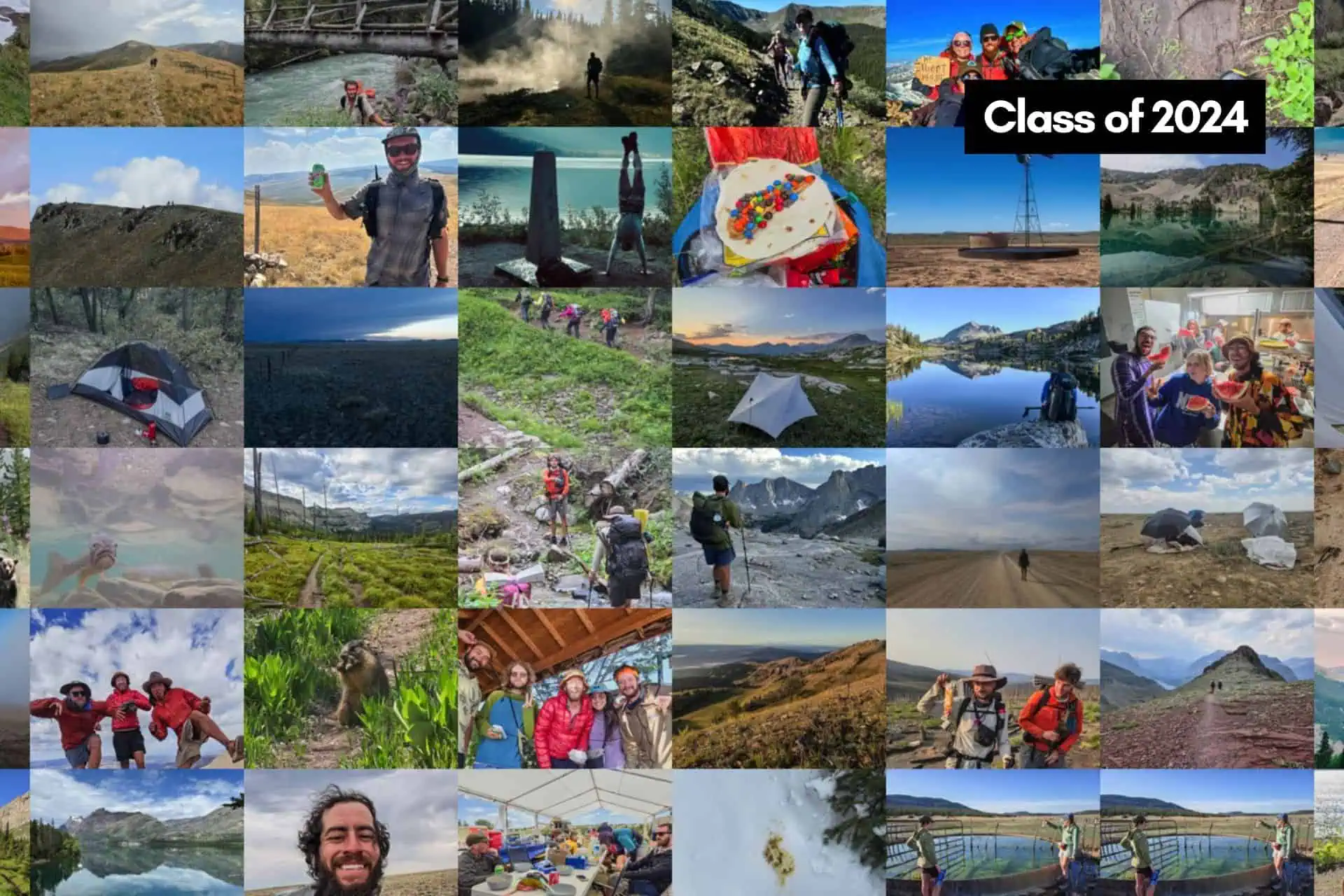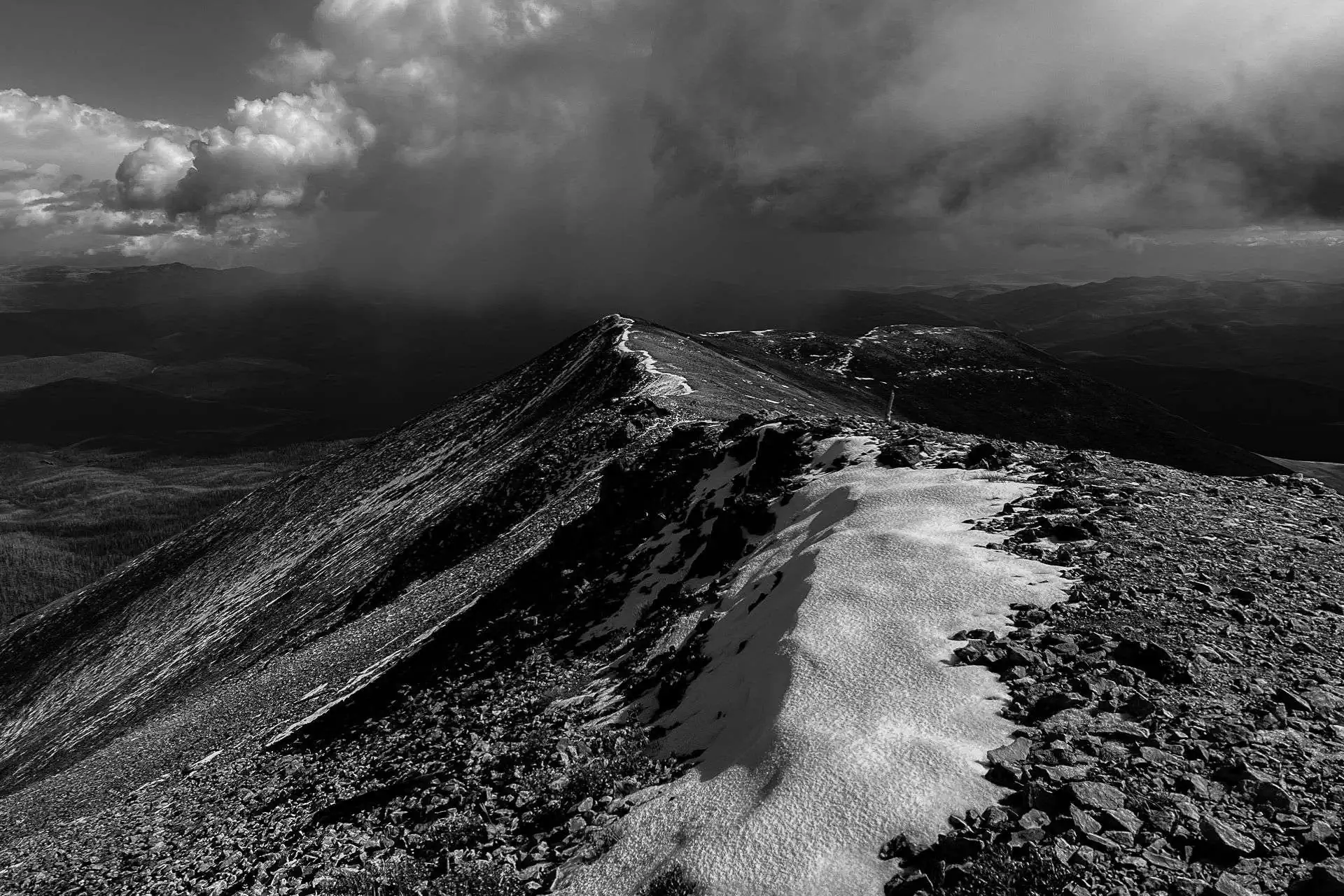Continental Divide Trail Resupply Guide (2024 Survey)
In the third installment of the Continental Divide Trail Thru-Hiker Survey, we cover what’s probably the biggest (perceived) logistical issue on the CDT: resupply. After hikers get their gear sorted, questions surrounding resupply become the object of CDT hiker fascination.
What is CDT resupply? It’s the replenishment of the food (and other consumable items) carried in a hiker’s backpack. Basically, buying more food and supplies on the trail. Contrary to popular belief, CDT hikers commonly leave the trail and venture into towns to buy more food; they don’t carry all their food (for the entire hike) from the beginning. And, perhaps even more shockingly, the idea that thru-hikers subsist on a diet of foraged mushrooms and edible plants is a lie.
I often advise hikers not to worry about resupplying before beginning a thru-hike, but I am not always believed. Barring any dietary restrictions or a tight resupply schedule (i.e., you’re on a CDT speed run), there’s little reason to stress about where you’ll buy food in Colorado in a few months. The Continental Divide Trail runs society adjacent, and it isn’t difficult to get somewhere to pause and organize yourself and your hike.
Using data from the 2024 Continental Divide Trail Hiker Survey, I’ve compiled the following picture of what resupply looks like over the course of a Continental Divide Trail thru-hike. Hopefully, this helps all you would-be CDT thru-hikers rest a little easier.
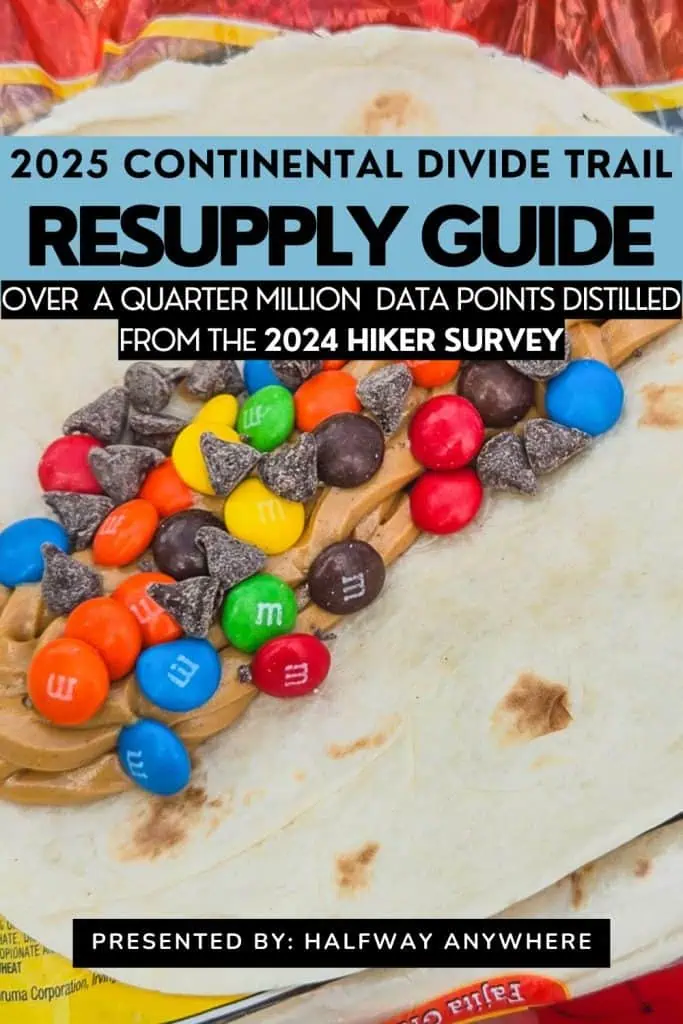
Notes on the Data
- This year, there were 213 completed surveys. Hiking next year? Sign up to take the survey here.
- Some responses are sorted and colored – e.g., northbound or southbound. More on this below.
- The Continental Divide Trail and thru-hiking generally use acronyms and jargon. If anything is unclear, the thru-hiker glossary may help. Please comment if you still can’t find what you’re looking for.
- I refer to survey respondents collectively as this year’s “class.” Remember, this is a sample.
- These results invoke basic statistics. To maximize your time here, familiarize yourself with average, median (M), and standard deviation (σ).
- More detailed posts focused on CDT Gear, CDT Horror Stories, and CDT Advice in the coming weeks. If you would like to be notified of new surveys, click here.
If no color/label has been appended to a data point, I used all collected data (i.e., it includes section hiker data and data from hikers who did not complete the trail).
Unless otherwise noted, I use the following colors to differentiate each section of the Continental Divide Trail. These colors are typically used in the graphs below.
- New Mexico, Colorado, Wyoming, Idaho/Southern Montana, Northern Montana
Resupply Strategy
When you find yourself in town along the Continental Divide Trail, you have the following options in terms of your resupply:
- Buy yourself a full resupply (replenish your food stocks from zero back to a level sufficient to get you to the next resupply point)
- Buy yourself a partial resupply (boost your current stock to get you through to the next resupply point – i.e., get more snacks)
- Pick up a package you’ve sent yourself at a post office or hiker-friendly place along the trail (like a hotel or trail angel).
- Get a large enough meal to last until the next town (some hikers are fond of doing this at the Cajon Pass McDonald’s).
- Skip the town entirely and crush miles to your next resupply.
Sometimes, your options are limited to a gas station or a very expensive general store (where some hikers may prefer to send themselves packages). Other times, you’ll find yourself in a large town with a supermarket (this is a good place to get a resupply to send ahead somewhere).
Before delving into the “best” strategy for CDT resupply, I must warn you (again) not to fall into the trap of attempting to plan your entire hike ahead of time. It (probably) is not going to work (although I’ve been proven wrong in the past).
Unless you have specific dietary restrictions or some very compelling reason, there is little reason to plan your resupply stops ahead of time. It’s like worrying about how you’ll get home when you reach the northern/southern terminus; it doesn’t matter to you who has yet to walk a single step. Trust me, there will be plenty of time on the trail to figure out your resupply. (I’m an internet stranger, so you have to.)
With this in mind, let’s examine the CDT Class of 2024’s resupply.
Resupply Boxes
Buying your food and prepping boxes before your hike can be tempting for the first-time thru-hiker, even the experienced but uncertain thru-hiker. A (false) sense of security comes from packing up resupplies before the trail – a kind of “Well, I’ve got all that sorted out.” Except on the trail, all that planning/sorting you did beforehand can prove more of a liability than an asset.
Plans change, post offices aren’t always open, boxes get lost, and hikes end early – a lot can happen between your start date and the resupply box you hop(ed) to retrieve weeks or months later.
On top of all that, unless you’ve done a long-distance hike before, it can be hard to imagine what you, in a month (or two…or three…), will want to eat all day after having hiked hundreds of miles.
But since practically all hikers send at least some boxes, let’s examine how many boxes were sent, how many were prepped ahead of time, how frequently they were sent, and what was done before starting vs. on the trail.
Resupply Strategy
- 1.6% – Mailed all resupply
- 8.2% – Mailed most resupply (> 50%)
- 40.2% – Mailed some resupplies (10-50%)
- 45.1% – Mailed a few resupply (1-10%)
- 4.9% – Mailed no resupply
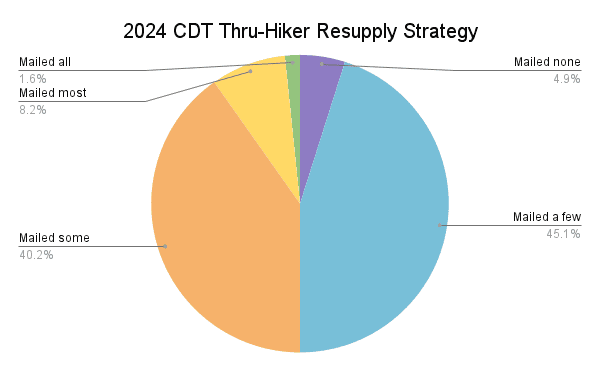
2024 Thru-Hikers
- 1.6% – Mailed all resupply
- 8.2% – Mailed most resupply (> 50%)
- 40.2% – Mailed some resupplies (10-50%)
- 45.1% – Mailed a few resupply (1-10%)
- 4.9% – Mailed no resupply
2023 Thru-Hikers
- 6.2% – Mailed all resupply
- 7.5% – Mailed most resupply (> 50%)
- 41.8% – Mailed some resupplies (10-50%)
- 41.8% – Mailed a few resupply (1-10%)
- 2.7% – Mailed no resupply
As with most years (every year), most hikers split their resupplies between buying locally and sending resupply boxes.
Number of Resupply Boxes
This chart shows the number of resupply boxes by Continental Divide Trail thru-hikers (1).
Average: 6.6
Median: 6
σ: 5.3
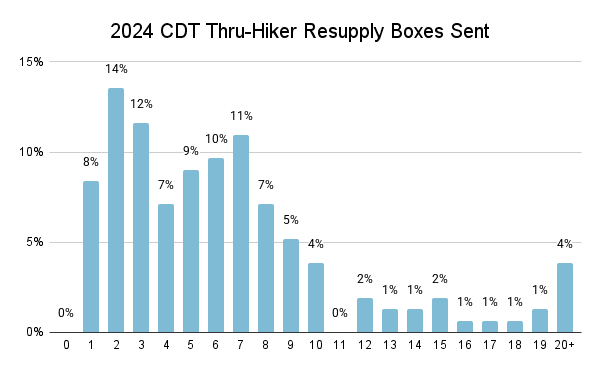
Thru-Hikers
3.8
The average number of resupply boxes prepared ahead of time
(M = 2 | σ = 5.5)
Thru-Hikers (1)
7
The average total number of resupply boxes sent
(M = 6 | σ = 5.3)
Thru-Hikers (1)
21%
The average percent of resupplies sent as boxes
(M = 10% | σ = 22.6%)
Resupply Boxes Prepared Pre-Trail
As part of CDT resupply planning, many hikers (but not all) prepare resupply boxes ahead of time. Here are the stats for the number of boxes thru-hikers prepared before starting the trail.
Average: 4.0
Median: 2
σ: 5.6
Note: You can buy and prepare resupply boxes from on the trail; you don’t need all your boxes ready before you begin your hike.
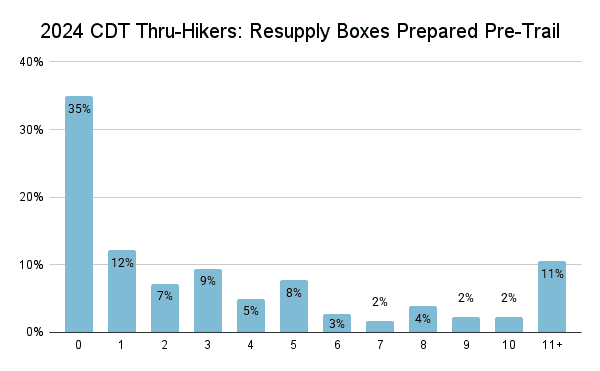
Thru-Hikers (1)
12.6%
The percentage of hikers who said they would have liked to have sent fewer resupply boxes during a thru-hike
Thru-Hikers (1)
6
The average number of resupply boxes sent by hikers who said they would have liked to have sent fewer resupply boxes
Thru-Hikers (1)
0.6%
The percentage of hikers who said they would have liked to have prepared no resupply boxes before beginning their thru-hikes
Boxes Mailed from the Trail
As many CDT hikers learn (and what I’m here to tell you now) is that you can mail yourself resupply boxes from the trail. This strategy is a smart one because you will not only have a better idea of your daily mileage and your food preferences after you begin hiking, but you’ll be able to ensure you don’t waste time (and money) ahead of time prepping resupply boxes you may end up not enjoying or never even using (if you have to get off the trail or skip a section due to fire, snow, or trail closures).
Here are the stats for the number of boxes that thru-hikers (1) sent to themselves while on the trail.
Average: 3.1
Median: 2
σ: 3.6
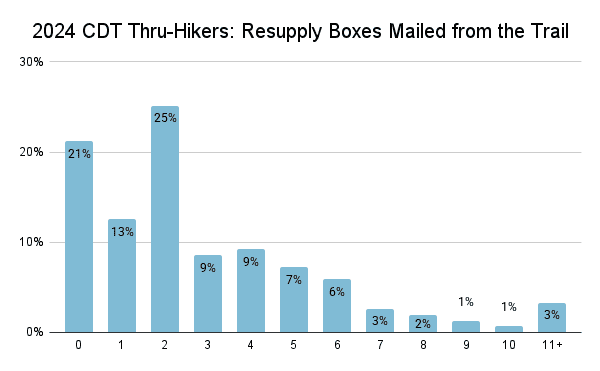
Thru-Hikers (1)
9.4%
The percentage of hikers who said they would have liked to have sent more resupply boxes during a thru-hike
Thru-Hikers (1)
6
The average number of resupply boxes sent by hikers who said they would have liked to have sent more resupply boxes
Thru-Hikers (1)
0.6%
The percentage of hikers who said they would have liked to have prepared all their resupply boxes before beginning their thru-hikes
Remember, there is no “correct number of CDT resupply boxes”, but there are places where a prepackaged and curated selection of your preferences will be preferable to the local selection (more on where those places may in the next section).
Where to Mail CDT Resupply Boxes
As part of the CDT Survey, I asked hikers where they recommend sending a resupply box. Hikers’ motivations for sending a resupply box to a location on the trail can range from “the selection is bad, and everything is expensive” to “the store owners are awful people, and we should not support them.” Regardless of their reasons, here’s where the CDT Class of 2024 thinks you should send yourself resupply boxes.
If there’s any confusion, the locations are listed in descending order (not geographical order). The percentages reflect the percentage of this year’s class who indicated that they would “definitely send a resupply box” to each location.
Suggest Mailing Resupply
- Pie Town (New Mexico) 81.9%
- Ghost Ranch (New Mexico) 36.9%
- East Glacier Village (Northern Montana) 32.5%
- Lima (Idaho/Southern Montana) 32.5%
- Leadore via Bannock Pass (Idaho/Southern Montana) 30.6%
- Doc Campbell’s (New Mexico) 28.1%
- Benchmark Wilderness Ranch (Northern Montana) 21.3%
- Encampment via Battle Pass (Wyoming) 18.8%
- Old Faithful Village in Yellowstone (Wyoming) 18.8%
- Atlantic City (Wyoming) 8.1%
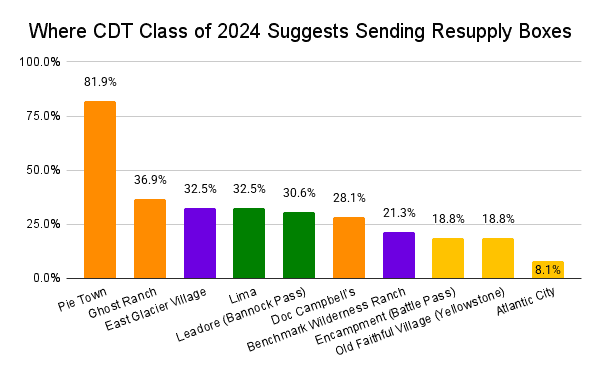
*This is the fifth year in a row that Pie Town, New Mexico, has been (overwhelmingly) at the top of the list.
Many hikers fail to realize that you can easily send yourself boxes from towns on the trail (instead of preparing your boxes ahead of time). You are not committed to your plan when you set foot on the trail.
The CDT is long, but it simply connects a series of smaller trails between resupply stops. Nothing is stopping you from going to a supermarket, buying yourself delicious hiker food, and mailing it to yourself further up the trail (unless it’s Sunday because the post office is closed on Sunday—which may sound unimportant now, but will be essential to remember while on the trail).
For the sake of simplicity, suppose you’re strictly following the averages of this year’s CDT class. The number of resupply boxes that you will send to each section of the CDT is:
- New Mexico: 3
- Doc Campbell’s, Pie Town, Ghost Ranch
- Colorado: 0
- Wyoming:
- 3 Encampment/Battle Pass, Atlantic City, Old Faithful Village in Yellowstone
- Idaho/Montana: 4
- Lima, Leadore/Bannock Pass, Benchmark Wilderness Ranch, East Glacier Village
Changes to CDT Resupply Strategy
To help future Continental Divide Trail hikers devise a successful CDT resupply strategy, I asked them what they would have changed about resupply. This year, 37.7% of thru-hikers said they would change something about their resupply strategy. The following percentages are of these hikers (who said they would change something).
- 32.3% – Send fewer resupply boxes throughout the trail (6 was the average number of boxes sent by hikers who said this)
- 24.2% – Send more resupply boxes throughout the trail (6 was the average number of boxes sent by hikers who said this)
- 21.0% – Include healthier food in their resupplies (yes, you can survive on M&M’s – but should you?)
- 16.1% – Include more variety in their resupplies (Clif bars and Stroopwafels will only get you so far)
- 9.7% – Resupply more frequently (more frequent resupplies mean less weight carried, but also more time in town)
- 9.7% – Send more food in their resupplies
- 8.1% – Mail resupply boxes from on the trail instead of ahead of time
- 8.1% – Resupply less frequently (less frequent means longer distances between resupplies)
- 6.5% – Include less food in their resupplies (the challenge of how much food to buy remains constant throughout the trail)
- 1.6% – Prepare no resupply boxes ahead of time
- 1.6% – Prep all their resupply boxes ahead of time
Favorite Hiker Meals & Snacks
Another Continental Divide Trail resupply consideration? What foods are you going to be resupplying with?
I would love to eat a Costco-sized bag of M&M’s with a large brick of cheese and a bottle of Sriracha for each section of the trail, but I’ve been told this isn’t healthy (and 21% of CDT hikers said they wish they had resupplied with more nutritious food).
So, what do CDT hikers eat? Berries, insects, dirt, fallen CDT hikers? Obviously. But there’s so much more on offer at (most) CDT resupply stops.
Favorite Backpacking Meals
- Ramen 35.5%
- Knorr Rice Sides 31%
- Peak Refuel 28.4%
- Idohoan Mashed Potatoes 23.2%
- Couscous 20%
- Mountain House 17.4%
- Annie’s Mac & Cheese 15.5%
- Backpacker’s Pantry 13.5%
- Good To-Go 11%
- Mac & Cheese (not Annie’s) 9.7%
Favorite Backpacking Snacks
- Cheese 29.6%
- M&M’s 25.1%
- Dried Fruit 24%
- Peanut Butter 20.1%
- Snickers Bars 19%
- Potato Chips 18.4%
- Bobo’s Oat Bars 16.8%
- Fritos 16.8%
- Sour Patch Kids 16.8%
- Sour Gummy Worms 16.2%
How Frequently to Resupply
Predicting (with any degree of accuracy) where you will resupply before beginning a thru-hike is something many hikers attempt despite my telling them it’s unnecessary. Do you know how long it will take to walk 100 mi / 160 km two months into your hike with three days of unscheduled rain and too much food in your pack?
The weather, your physical condition, the people you’re with, where you’ve just come from, where you’re going, and many other factors make this a (somewhat) educated guess at best.
Maybe you’ll prefer carrying more food and resupplying less often. Perhaps you’ll prefer a lighter load with more frequent stops in town. Maybe you’ll be injured or quit in the first week (or die), and none of this will even matter.
So, what’s the right balance between resupply and hiking? It’s different for everyone. This is a response that many of you may not want to hear, but it is also the most accurate response I can offer. That said, here’s a look at this year’s hikes regarding resupply.
Thru-Hikers (1)
140
The average number of days it took hikers to complete the CDT
(M = 141 | σ = 19)
Thru-Hikers (1)
16
The average number of zero days taken during a thru-hike
(M = 14 | σ = 8.7)
Thru-Hikers (1)
14
The average number of nearo days (low mileage days)
(M = 11 | σ = 5.3)
Northbound Hike Breakdown
The average number of days it took hikers to complete:
- 40 – New Mexico
- 41 – Colorado
- 27 – Wyoming
- 41 – Idaho+Montana
- 146 – Average days for northbound (1) to complete the CDT.
Southbound Hike Breakdown
The average number of days it took hikers to complete:
- 46 – Idaho+Montana
- 27 – Wyoming
- 35 – Colorado
- 31 – New Mexico
- 133 – Average days for southbound (1) to complete the CDT.
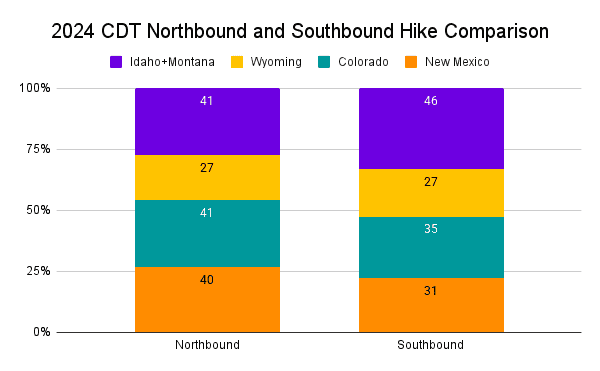
Thru-Hikers (1)
28
The average number of resupplies over the entire trail
(M = 28 | σ = 6.2)
Thru-Hikers (1)
6
The average number of days between resupplies
(M = 5 | σ = 1.8)
Thru-Hikers (1)
119
The average number of miles between resupplies (191 km)
(M = 109 mi / 175 km | σ = 39 mi / 63 km)
Average Resupplies Per Section
- 7.6 New Mexico (M=8)
- ~ every 101 mi / 163 km
- 8.3 Colorado (M=8)
- ~ every 94 mi / 151 km
- 5.5 Wyoming (M=6)
- ~ every 92 mi / 148 km
- 3.9 Idaho/Southern Montana (M=4)
- ~ every 108 mi / 174 km
- 5.2 Northern Montana (M=5)
- ~ every 113 mi / 182 km
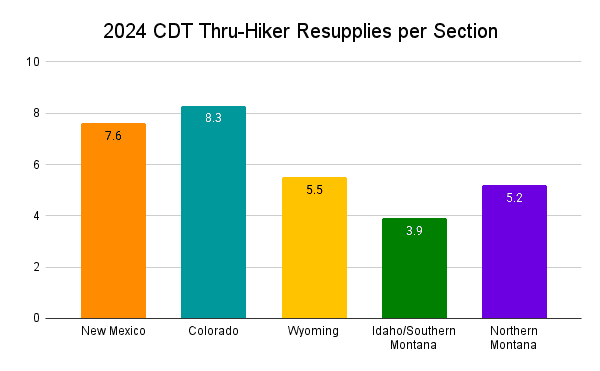
Stretches between resupply can vary greatly, especially depending on which alternates you take, and some will be much longer (or shorter) than others. This should give you a rough idea of what to expect.
Average CDT Resupply Plan
Based on survey responses, we can determine what an “average” Continental Divide Trail hiker’s resupply looked like for a 2024 thru-hike. Below is a list of all the CDT resupply stops where hikers stopped this year, accompanied by the percentage of hikers who stopped at each location.
Resupply stops are listed in geographical order from Mexico to Canada (that’s south to north, in case you’re unsure). Again, I use the following colors to indicate each resupply stop’s popularity: over 75%, 50-75%, 25-50%, and under 25%.
New Mexico Resupply
- Hachita – 3.2%
- ⛺ Lordsburg – 97.5%
- ⛺ Silver City – 96.2%
- ✉️⛺ Doc Campbell’s – 93.0%
- Reserve – 14.6%
- Davila Ranch – 4.4%
- ✉️⛺ Pie Town – 86.7%
- Quemado – 3.2%
- ⛺ Grants – 94.3%
- Albuquerque – 5.7%
- ⛺ Cuba – 95.6%
- Española – 0.6%
- Santa Fe – 12.7%
- Abiquiu – 12.7%%
- ✉️⛺ Ghost Ranch – 55.7%
- Taos – 0.6%
- Chama via Cumbres Pass – 92.4%
Colorado Resupply
- Pagosa Springs via Wolf Creek Pass – 77.9%
- South Fork via Wolf Creek Pass – 4.5%
- Platoro – 6.5%
- Del Norte – 7.8%
- Creede – 36.4%
- Silverton via Stony Pass – 14.9%
- Durango – 7.1%
- Lake City via Spring Creek Pass – 51.9%
- Sargents – 0.6%
- ⛺ Monarch Mountain Lodge – 8.4%
- Monarch Spur RV Park – 0.6%
- Salida via Monarch Pass – 87.7%
- Gunnison – 2.6%
- Poncha Springs – 0.6%
- Buena Vista – 26.6%
- ⛺ Twin Lakes – 60.4%
- Leadville – 68.2%
- ⛺ Copper Mountain – 11.0%
- Breckenridge – 38.3%
- Frisco – 29.9%
- Idaho Springs 0.6%
- Silverthorne – 27.3%
- Dillon – 10.4%
- Winter Park – 36.4%
- Fraser – 14.3%
- Denver – 10.4%
- ⛺ Grand Lake – 92.2%
- Steamboat Springs via Rabbit Ears Pass – 94.2%
Wyoming Resupply
- ✉️ Encampment via Battle Pass – 56.0%
- Riverside via Battle Pass – 12.0%
- ⛺ Rawlins – 98.2%
- ⛺ Big Sandy Lodge – 6.6%
- ⛺ South Pass City – 17.5%
- ✉️ Atlantic City – 10.8%
- Lander – 74.7%
- Pinedale – 61.4%
- Lava Mountain Lodge via Togwotee Pass – 2.4%
- Dubois via Togwotee Pass – 68.1%
- Togwotee Mountain Lodge – 0.6%
- Jackson – 22.3%
- ⛺ Brooks Lake Lodge – 7.2%
- Cody – 0.6%
- ⛺ Grant Village in Yellowstone – 34.3%
- ✉️⛺ Old Faithful Village in Yellowstone – 69.3%
- Mammoth Village in Yellowstone – 4.2%
- Flagg Ranch – 3.6%
Idaho/Montana Resupply
- West Yellowstone – 54.3%
- ⛺ Island Park / Mack’s Inn – 39.3%
- Big Sky – 10.0%
- Ennis – 7.1%
- ✉️ Lima – 82.1%
- ✉️ Leadore via Bannock Pass – 82.9%
- Tendoy – 0.7%
- Salmon – 8.6%
- Jackson – 5.7%
- Missoula – 5.0%
- Darby via Chief Joseph Pass – 68.6%
- Hamilton via Chief Joseph Pass – 5.7%
- Darby via Lost Trail Pass – 7.1%
- Hamilton via Lost Trail Pass – 1.4%
- Camp Sula – 3.6%
- Wisdom – 3.6%
- ⛺ Anaconda – 64.9%
- Whitehall – 10.1%
- Butte – 43.5%
- Bozeman – 11.9%
- Helena – 81.5%
- Elliston – 14.9%
- ✉️ Lincoln – 67.9%
- ⛺ Benchmark Wilderness Ranch – 22.6%
- ✉️ Augusta – 55.4%
- ⛺ East Glacier Village – 95.2%
- Browning – 3%
- ⛺ Two Medicine – 12.5%
- Saint Mary – 15.5%
- ⛺ Many Glacier – 25%
✉️ Stops where this year’s class suggests sending resupply boxes
⛺ Stops that can be reached without hitchhiking or road walking
Based on this information, how would our average Continental Divide Trail thru-hiker resupply? It would resemble the following. Note: names in bold with a ✉️ indicate locations where hikers suggest mailing a resupply box.
New Mexico
- Mile 83: Lordsburg
- Mile 156: Silver City
- ✉️ Mile 40 of Gila Alternate: Doc Campbell’s
- ✉️ Mile 415: Pie Town
- Mile 523: Grants
- Mile 628: Cuba
- Mile 780: Chama via Cumbres Pass
Colorado
- Mile 848: Pagosa Springs via Wolf Creek Pass
- Mile 964: Lake City via Spring Creek Pass
- Mile 1064: Salida via Monarch Pass
- Mile 1147: Twin Lakes
- Mile 1185: Leadville
- Mile 1220: Breckenridge
- Mile 1290: Winter Park
- Mile 1343: Grand Lake
- Mile 1436: Steamboat Springs via Rabbit Ears Pass
Wyoming
- ✉️ Mile 1529: Encampment via Battle Pass
- Mile 1611: Rawlins
- Mile 1732: Lander
- Mile 1808: Pinedale
- Mile 16.1 of Old CDT Alt: Dubois via Togwotee Pass
- ✉️ Mile 2000: Old Faithful Village in Yellowstone
Idaho/Montana
- Mile 2051: West Yellowstone
- ✉️ Mile 2146: Lima
- ✉️ Mile 2250: Leadore via Bannock Pass
- Mile 2381: Darby via Chief Joseph Pass
- Mile 27 of Anaconda Cutoff: Anaconda
- Mile 2640: Helena
- Mile 2706: Lincoln
- Mile 2763: Augusta
- ✉️ Mile 2895: East Glacier Village
Note: This is for educational purposes only and is not necessarily a good (or decent) resupply strategy. Please do not blindly follow this; instead, use it as a guide.
Between many resupply stops, you may pass a location where you can get a meal (Cuba in New Mexico, for example) or a place where you can buy some snacks (Monarch Pass in Colorado, for example). Remember that this post is meant to gently guide you towards a more successful resupply plan (whatever that means – since, as I’ve already told you, planning resupplies is not a wise investment of your time).
Favorite (& Least Favorite) Resupply Stops
The Continental Divide Trail is mostly about hiking (the worst), but the towns along the trail also play a role in the CDT experience. This is why I ask about hikers’ favorite and least favorite resupply points. Take note that when asking this question, I specify “‘Favorite/Least Favorite’ means where [hikers] most/least enjoyed, not where had the best/worst resupply options (although these could be the same).”
Here’s what we came up with (for each section).
Favorite Resupply Stop
Silver City, NM
31% of hikers voted for Silver City
Least Favorite Resupply Stop
Lima, MT
32% of hikers voted for Lima
Favorite Resupply Stops
- New Mexico: Silver City (28%)
- Colorado: Leadville (25%)
- Wyoming: Lander (29%)
- Idaho/Montana: Anaconda (30%)
Runners-Up
- New Mexico: Doc Campbell’s (17%)
- Colorado: Salida (25%)
- Wyoming Pinedale (21%)
- Idaho/Montana: East Glacier Village (20%)
Least Favorite Resupply Stops
- New Mexico: Cuba (29%)
- Colorado: Grand Lake (8%)
- Wyoming Encampment (11%)
- Idaho/Montana: Lima (32%)
Runners-Up
- New Mexico: Pie Town (22%)
- Colorado: Steamboat Springs (7%)
- Wyoming Rawlins (8%)
- Idaho/Montana: Leadore (19%)
Hitchhiking to Town
What about hitchhiking to resupply stops?
You may not realize it, but hitchhiking often plays a big role on the Continental Divide Trail. It’s not unusual (and is actually quite common) for hikers to hitchhike to town to buy or pick up resupplies.
As part of the CDT Survey, I ask hikers what resupply stops (if any) they had difficulty hitchhiking to from the trail. The top responses were (from south to north).
Difficult Hitches
- Chama via Cumbres Pass (New Mexico/Colorado) 21.1%
- Augusta (Northern Montana) 18.9%
- Leadore via Bannock Pass (Idaho/Southern Montana) 18.9%
- Encampment via Battle Pass (Wyoming) 14.4%
- Lander (Wyoming) 14.4%
- Lima (Idaho/Southern Montana) 14.4%
- Dubois via Togwotee Pass (Wyoming) 5.7%
- Lincoln (Idaho/Southern Montana) 10%
- Steamboat Springs via Rabbit Ears Pass (Colorado) 10%
- Pagosa Springs via Wolf Creek Pass (Colorado) 8.9%
These percentages are of the hikers who said they had difficulty hitchhiking to at least one location.
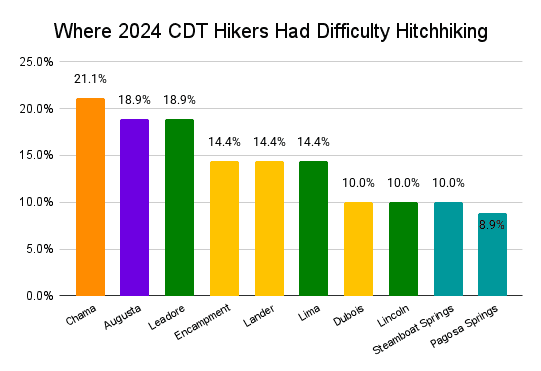
Note: 43.4% of thru-hikers (1) reported having no trouble hitchhiking.
Remember, hitchhiking can be a very subjective/random experience. You may get a ride with the first car that passes a place where others stand waiting for hours. Don’t start crying if nobody picks you up after an hour (or even two), don’t hate on people who call a Lyft/Uber/taxi (definitely an option at some trailheads), and don’t yell at or flip off drivers who don’t stop for you.
Dietary Restrictions
For the final piece of the resupply puzzle, we look at hikers’ dietary restrictions and how easy they found resupplying with them.
Dietary Restrictions
- 43.2% – Has dietary restriction
- 56.8% – No dietary restriction
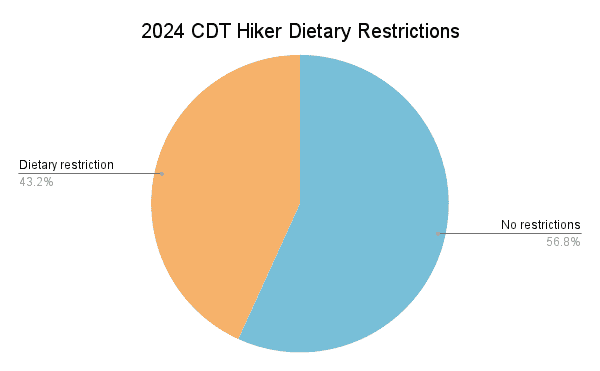
Specific Dietary Restrictions
- 34.6% – Vegetarian
- 25.0% – Vegan
- 19.2% – Beef-free
- 15.4% – Pescatarian
- 13.5% – Dairy-free
- 9.6% – Gluten-free
- 9.6% – Lactose intolerance
- 9.6% – Lactose-free
- 3.8% – Kosher
- 3.8% – Tree-nut allergy
- 1.9% – Peanut allergy
- 3.8% – Other
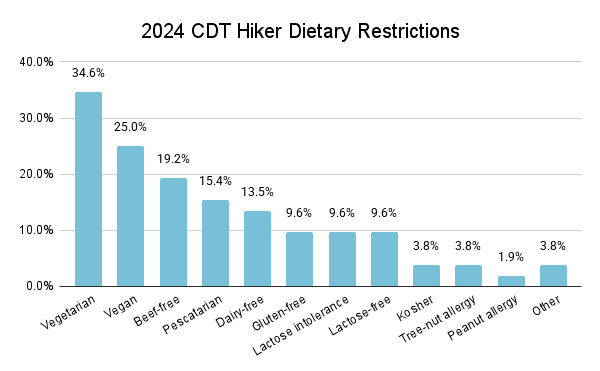
Note: These percentages are of the hikers who reported a dietary restriction.
Trouble With Dietary Restrictions
On a scale of 0 to 10 (0 being easy, 10 being difficult), I asked hikers with dietary restrictions how difficult it was to accommodate their diets while on the trail.
- 5.0 – Kosher
- 4.3 – Vegan
- 4.3 – Vegetarian
- 4.0 – Gluten-free
- 3.5 – Lactose-free
- 3.0 – Peanut allergy
- 2.8 – Lactose intolerance
- 2.4 – Dairy-free
- 2.2 – Pescatarian
- 1.6 – Beef-free
- 0.5 – Tree-nut allergy
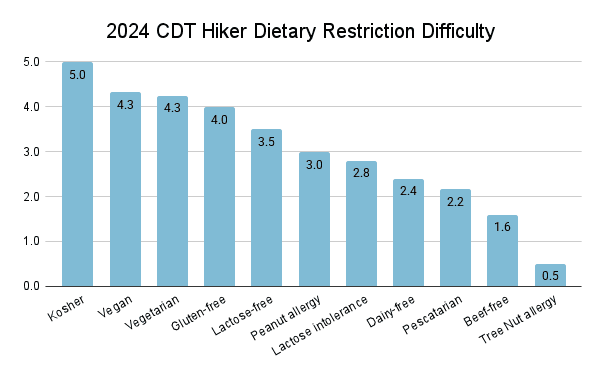
Resupply Advice
We’ve covered a lot thus far, but enough with the numbers, colored labels, and bulleted lists of places you may or may not have ever heard of. What did thru-hikers have to say about Continental Divide Trail resupply?
- Be prepared for long food hauls or hike fast. You won’t have access to roads and towns like you do on the Appalachian Trail, so be confident you have enough to get to the next town.
- Boxes are not required, but they make it less stressful if you are a Type A personality or have dietary restrictions. Make sure you vary what you buy because you will get sick of things you like in the beginning. Don’t be on a bar diet!
- Endeavor to be able to do a full resupply from just a convenience store. It makes resupplying much easier.
- Before the trail, I did not have faith in small-town America’s vegan options. While restaurants were scarce, resupplying was easy in most towns! I’d recommend vegans send a box to Lake City, Lima, Leadore, East Glacier, and Pie Town—but otherwise, resupplying is doable everywhere.
- I had boxes made for all the tough resupplies in New Mexico before I left. It was nice not to have to think about it, but be wary of getting into towns on a Friday or Saturday expecting the USPS to always be open.
- If you’re a bit picky like me and don’t like a diet of ramen, Knorr sides, Honey Buns, and Snickers, send boxes to all smaller towns. If you’re fine with what’s commonly on offer at Family Dollar or Dollar General, you’ll be fine with very few boxes.
- There are a few spots where you would benefit from having a box. Put a variety of things in those boxes that equal your calorie requirements. Everything else will sort itself out along the way. Think a month ahead, the postal system is sometimes slow or unreliable in the smaller communities.
- When possible, mail resupply boxes to businesses/hotels/trail angels/etc, rather than post offices to avoid post office hours.
- You cannot buy healthy food in Lima and Leadore. Having a box with healthy food for at least one of these towns would be nice because it’s a long way from Darby to West Yellowstone/Macks Inn without it.
But most of all – have fun out there! And don’t die.
Support the Survey
Every year, I get a lot of people asking how to support the surveys. Beyond sharing them with your close-knit bubble of weird hiker friends, the best way to support the survey is to contribute via Patreon. You’ll get access to exclusive posts, discount codes, live streams, and super, extra cool stickers so that everyone will know how cool you are.
If you’re not into Patreon, that’s cool; you can Venmo @halfwayanywhere, Cash app $halfwayanywhere, or PayPal moc.erehwynayawflah@tcatnoc
This is not expected. The data collected in the survey will always be free and accessible to everyone who wants/needs it. Your support is much appreciated and helps pay the website (and survey) bills.



CDT Survey Collection
If there is anything you can think of that would make this information more useful (or any more resupply-related cross-referencing you would like to see), please leave a comment and let me know.
For more on CDT Resupply, check out these articles.
Affiliate Disclosure: This page may contain affiliate links, which means I may receive small commissions for purchases made via these links at no additional cost to you. This helps pay the bills and keep the site up and running. Thank you for your support!
